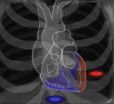(Press-News.org) Saying goodbye to summer can be difficult for everybody. In some people the onset of winter triggers Seasonal Affective Disorder, or SAD, a mood disorder in which sufferers experience symptoms of depression. Happily, a special kind of gerbil exhibits remarkably similar reactions to SAD treatments as humans, opening a promising new channel for study and treatment of the common complaint.
With her work on the Israeli desert inhabitant gerbil called the Fat Sand Rat (Psammomys obesus), Prof. Noga Kronfeld-Schor of Tel Aviv University's Department of Zoology and her fellow researcher, Prof. Haim Einat of the University of Minnesota, have found new hope for the study of these and similar disorders. Her results, recently published in the International Journal of Neuropsychopharmacology, indicate that her new test subjects are more suitable model animal for the study of SAD than the rats and mice used previously.
Until now, Prof. Kronfeld-Schor explains, most research on the mechanisms of affective disorders was carried out on mice and rats. But this has been problematic in applying the research results to humans ― mice are nocturnal, while humans are diurnal. Clearly, when we conduct research of disorders like SAD which affect our circadian system, she says, our model animals should be diurnal as well.
Different as night and day
Most laboratory mice don't produce melatonin, a natural hormone produced by humans and other mammals during the night. Moreover, as nocturnal animals, mice and rats become more active at night, when melatonin levels are high, while humans are active during the day, when melatonin levels are now. For most biomedical research, Prof. Kronfeld-Schor explains, mice are excellent model subjects. But for affective disorders, which rely heavily on the human circadian system, she hypothesized that a diurnal mammal would provide a superior animal model.
To test this theory, Prof. Kronfeld-Schor and her fellow researcher put two groups of Fat Sand Rats through several experiments. First, to test the effect of the length of light exposure on the rats' emotional state, one group was exposed to long hours of light similar to that of the summer season, and the other to shorter hours of the winter length daylight. In several tests, the sand rats of the second group behaved in ways similar to depressed humans, exhibiting despair, reduced social interactions and increased anxiety.
Once the researchers established that Fat Sand Rats and humans had a similar reaction to light, the team explored whether common medications or other SAD therapies would be as effective in their rat population. These studies included a variety of medications commonly used to treat the disorder in humans, as well as a program of exposing the depressed sand rats to brighter light for one hour every morning or evening.
More than a placebo
According to Prof. Kronfeld-Schor, the results were surprising. The medications were effective in treating the sand rats' depression, but even more effective was the daily exposure to bright light in the mornings, a common treatment for human SAD. "Humans have been using this treatment for a long time," she explains, "but many of us thought that a large part of its success was based on the placebo effect. For the first time, we've found it to be effective in animals as well, which weakens the possibility of the placebo effect."
The breakthrough, says Prof. Kronfeld-Schor, is the discovery of a superior and viable animal model for studying affective disorders. Though several biological mechanisms for SAD have been proposed, they have not been scientifically proven. A good animal model to study the mechanisms of SAD will advance understanding of the disorder, help screen for effective treatments and allow for the development of new therapies.
INFORMATION:
American Friends of Tel Aviv University (www.aftau.org) supports Israel's leading, most comprehensive and most sought-after center of higher learning. Independently ranked 94th among the world's top universities for the impact of its research, TAU's innovations and discoveries are cited more often by the global scientific community than all but 10 other universities.
Internationally recognized for the scope and groundbreaking nature of its research and scholarship, Tel Aviv University consistently produces work with profound implications for the future.
Fat sand rats are SAD like us
Tel Aviv University shines a light on a mood disorder
2010-11-09
ELSE PRESS RELEASES FROM THIS DATE:
UCLA uses new hybrid, precision heart procedures to help stop deadly arrhythmias
2010-11-09
New techniques now being used at UCLA allow doctors to more precisely target certain areas of the heart to stop ventricular arrhythmias — serious abnormal rhythms in the heart's lower chambers — in high-risk patients.
Generally, arrhythmias can be controlled by medications, and sometimes defibrillators. But a potentially life-threatening, recurrent arrhythmia known as a ventricular tachycardia, which originates in one of the heart's two ventricles, can produce a fast heart beat that requires other interventions, such as catheter ablation, in which the precise focus ...
Children find their own way to solve arithmetic problems
2010-11-09
Children with learning difficulties can benefit from being encouraged to find their own way to solve arithmetic problems, according to new research from the University of Strathclyde in Glasgow, Scotland.
A study by Dr Lio Moscardini, in Strathclyde's Faculty of Humanities & Social Sciences, found that children deal better with arithmetical problems if they can use their own intuitive strategies such as using number blocks, drawings or breaking an equation up into smaller, simpler parts- rather than being instructed in arithmetical facts and procedures.
All the teachers ...
Brain bleeding is common with aging, UCI study finds
2010-11-09
Irvine, Calif., Nov. 8, 2010 — A small amount of bleeding in the brain seems to be common among older individuals, according to a UC Irvine study.
Neurologist Dr. Mark Fisher and neuropathologist Dr. Ronald Kim found that cerebral microbleeds are highly prevalent in the aging brain – and not primarily products of stroke-related injury, hypertension or neurodegenerative diseases such as Alzheimer's, as had been thought.
"Prior work relied on brain imaging to show cerebral microbleeds," Fisher said. "But in this study, deep regions of the brain were closely examined under ...
Scientists discover how the songbird's brain controls timing during singing
2010-11-09
AUDIO:
New research that reveals the activity of nerve cells in a songbird's brain as the bird sings a specific song is helping scientists to understand how birds string together sets...
Click here for more information.
A team of scientists has observed the activity of nerve cells in a songbird's brain as it is singing a particular song. Dezhe Jin, an assistant professor in the Department of Physics at Penn State University and one of the study's authors, explained that ...
Stevens and TNO conduct joint experiments in Dutch Harbor for maritime security
2010-11-09
Hoboken, NJ – Stevens Institute of Technology and the Netherlands Organization for Applied Scientific Research (TNO) have recently conducted joint experiments in the Dutch Navy Harbor of Den Helder, where passive acoustic systems from both parties were combined. Initial experimental results are presented at the Waterside Security (WSS) 2010 conference. This important experimental campaign was financed by the Netherlands Ministry of Defence.
The collaboration between Stevens and TNO was initiated in early 2010 after recognizing a strategic opportunity to form a long-term ...
TB-drugome provides new targets for anti-tuberculosis drug discovery
2010-11-09
Researchers at the University of California, San Diego School of Medicine and the University of Leeds have linked hundreds of federally approved drugs to more than 1,000 proteins in Mycobacterium tuberculosis, the causative agent of tuberculosis (TB), opening new avenues to repurpose these drugs to treat TB.
The study was published Nov. 4 in PLoS Computational Biology.
"Tuberculosis is currently one of the most widely spread infectious diseases, with an estimated one-third of the world's population infected and between one and two million people dying each year from ...
DHA improves memory and cognitive function in older adults
2010-11-09
WASHINGTON, D.C., November 8, 2010 — A study published in the November edition of Alzheimer's & Dementia: The Journal of the Alzheimer's Association suggests that taking docosahexaenoic acid (DHA) may improve memory and learning in older adults with mild cognitive impairments. This is promising news for many aging Americans who are searching for options to maintain memory and support overall cognitive health.
The "Memory Improvement with Docosahexaenoic Acid Study" (MIDAS) was a randomized, double-blind, placebo-controlled study to evaluate the effects of DHA—the principle ...
Nanogenerators grow strong enough to power small conventional electronics
2010-11-09
VIDEO:
In the laboratory of Zhong Lin Wang at Georgia Tech, a blinking LCD signals the success of a five-year effort to power conventional electronic devices using nanoscale generators that harvest...
Click here for more information.
Blinking numbers on a liquid-crystal display (LCD) often indicate that a device's clock needs resetting. But in the laboratory of Zhong Lin Wang at Georgia Tech, the blinking number on a small LCD signals the success of a five-year effort ...
Single parenthood doesn't pay off for plants
2010-11-09
Durham, NC —Many plants can pollinate themselves and reproduce without the aid of a mate, thanks to having both male and female parts. But the short-term perks of being able to go it alone come with long-term costs, says a new study in the journal Science. The reason is because plants that can pollinate themselves are more prone to extinction, scientists say.
Flowering plants are incredibly creative when it comes to sex, said co-author Boris Igic, a biologist at the University of Illinois at Chicago. "Plants just can't walk over to potential mates like we do. Many species ...
Frequency of foot disorders differs between African-Americans and whites
2010-11-09
CHAPEL HILL, N.C. – Common foot disorders such as flat feet, corns and bunions are more prevalent among African Americans than in whites, a new study by University of North Carolina at Chapel Hill researchers has found.
African Americans in the study age 45 or older were three times more likely than whites of the same age to have corns or flat feet (medical name: pes planus). In people who were not obese, African Americans were twice as likely to have bunions (hallux valgus) and hammer toes than whites, said Yvonne M. Golightly, PT, PhD, lead author of the study, titled ...
LAST 30 PRESS RELEASES:
URI researchers uncover molecular mechanisms behind speciation in corals
Chitin based carbon aerogel offers a cleaner way to store thermal energy
Tracing hidden sources of nitrate pollution in rapidly changing rural urban landscapes
Viruses on plastic pollution may quietly accelerate the spread of antibiotic resistance
Three UH Rainbow Babies & Children’s faculty elected to prestigious American Pediatric Society
Tunnel resilience models unveiled to aid post-earthquake recovery
Satellite communication systems: the future of 5G/6G connectivity
Space computing power networks: a new frontier for satellite technologies
Experiments advance potential of protein that makes hydrogen sulfide as a therapeutic target for Alzheimer’s disease
Examining private equity’s role in fertility care
Current Molecular Pharmacology achieves a landmark: real-time CiteScore advances to 7.2
Skeletal muscle epigenetic clocks developed using postmortem tissue from an Asian population
Estimating unemployment rates with social media data
Climate policies can backfire by eroding “green” values, study finds
Too much screen time too soon? A*STAR study links infant screen exposure to brain changes and teen anxiety
Global psychiatry mourns Professor Dan Stein, visionary who transformed mental health science across Africa and beyond
KIST develops eco-friendly palladium recovery technology to safeguard resource security
Statins significantly reduce mortality risk for adults with diabetes, regardless of cardiovascular risk
Brain immune cells may drive more damage in females than males with Alzheimer’s
Evidence-based recommendations empower clinicians to manage epilepsy in pregnancy
Fungus turns bark beetles’ defenses against them
There are new antivirals being tested for herpesviruses. Scientists now know how they work
CDI scientist, colleagues author review of global burden of fungus Candida auris
How does stroke influence speech comprehension?
B cells transiently unlock their plasticity, risking lymphoma development
Advanced AI dodel predicts spoken language outcomes in deaf children after cochlear implants
Multimodal imaging-based cerebral blood flow prediction model development in simulated microgravity
Accelerated streaming subgraph matching framework is faster, more robust, and scalable
Gestational diabetes rose every year in the US since 2016
OHSU researchers find breast cancer drug boosts leukemia treatment
[Press-News.org] Fat sand rats are SAD like usTel Aviv University shines a light on a mood disorder




